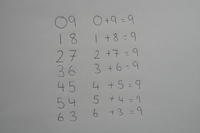Maths is Fun!
One of the clearest memories I have from my grammar school, Sir Joseph Williamson's Mathematical School in Rochester, Medway ("The Maths School" or "The Math" for short) is of my maths teacher, Mr Fry, telling us that "Maths is Fun!" I never really believed him at the time, but I am coming round to that way of thinking now. Another of Jim Fry's catchphrases was "Maths is pattern" and the more your child understands this the easier (and more fun!) they will find maths. One of my favourite patterns in maths which I encounter frequently in my role as an 11 plus tutor is the nine times table. Think of any number in the nine times table as being two numbers, for example think of 9 as "09", to get the next number in the series add one to the first number and take one from the second number so 2x9 is made up of 1 (0+1) and 8 (9-1), while 3x9 is made up of 2 (1+1) and 7 (8-1). You can also see that the digits in a multiple of 9 always add up to 9 (or, more rarely, to a multiple of 9 as in 99 where the digits add up to 18) - this is illustrated in the diagram. The is also a clever trick using your fingers to work out multiples of nine, for example to calculate 3x9 hold your hands out in front of you and bend down the top of the third finger, you will now have 2 fingers to the left of this finger and 7 fingers to the right, so the answer to 3x9 is 27.
Another useful trick in maths is finding out whether a number is a multiple of three: all you need to do is add up the digits and if the sum of the digits is a multiple of three then the number itself is a multiple of three, for example 27 is made up of 2 and 7, 2+7 = 9 which is a multiple of 3 so 27 is a multiple of three; 213 is made up of 2+1+3 which equals 6 so 213 is a multiple of 3 (71x3). This technique is particularly useful in determining whether or not a number is a prime number. Children are supposed to know all the prime numbers under 100 by the time they leave primary school. A working definition of a prime number is that "a prime number has only two factors, itself and 1" - 1 is not a prime number as it has only one factor, a factor being a whole number which, when multiplied by another whole number makes the number in question. For example the factors of 6 are 1, 6, 2 and 3 (since 1x6 = 6 and 2x3 = 6) whilst the factors of 4 are 1, 2 and 4 (as 4x1 = 4 and 2x2 = 4). Since one in three numbers are a multiple of three we can use this technique to eliminate one third of the numbers under consideration. Beware though, 91 is NOT a prime number because it is the product of 7 x 13.
On a lighter note, I try to relate maths to things that interest children (like food!). Cake and pizza analogies help children to make sense of fractions. The fraction 9/2 can be simplified by imagining that nine cakes are going to be shared between two people - each person would get 41/2 cakes so 9/2 = 41/2. I hope I have shown that Mr Fry was right and maths is quite fun after all - please use the comments box to let me know any ideas you have on how to make maths fun.



Comments